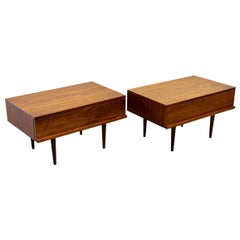Mel Smilow Nightstands
Recent Sales
Vintage 1960s American Mid-Century Modern Night Stands
Walnut
Vintage 1950s American Mid-Century Modern Night Stands
Wood, Walnut
Mel Smilow for sale on 1stDibs
“Enduring, modern and classic” is how mid-century modern furniture designer Mel Smilow used to describe his chairs, benches, coffee tables and other pieces, which were not only functional and durable but were designed to become timeless heirlooms for American families.
Smilow was born in the Bronx, New York, and, in 1939, attended Pratt Institute, where he studied to become a commercial artist. However, his father’s death forced him to discontinue his schooling and, at the age of 17, he took over his father’s role as a wholesale furniture salesman.
Following his stint in the army during World War II, Smilow partnered with colleague Morton Thielle in 1949 to form the furniture manufacturer and retailer Smilow-Thielle. Although they had planned to sell quality furniture made by American manufacturers, Smilow was unsatisfied with their designs and became Smilow-Thielle’s chief designer.
Throughout the 1950s and 1960s, Smilow used a variety of American hardwoods such as walnut, beech and oak for his benches, lounge chairs, sofas, table lamps, coffee tables, and other furnishings. One of his more popular designs was the Floating Platform bed — John Lennon and Yoko Ono owned one.
Although Smilow intended his designs to be comfortable and affordable for the “average American family,” his work was defined by the clean lines, delicate construction and symmetry often seen in Scandinavian modernist or Japanese furniture, and it drew attention and acclaim from designers and critics.
For instance, Buckminster Fuller placed Smilow’s rocking chairs in the geodesic dome he designed as the U.S. pavilion for Expo 1967, in Montreal, and Pratt Institute featured his ottoman as part of an exhibition of “well-designed furniture for under $25.” The New York Times, the New Yorker magazine and William Hennessey’s book Modern Furnishings for the Home also featured Smilow’s furniture.
Smilow-Thielle operated retail locations in the New York metro area as well as in Washington, D.C., with the firm’s flagship store occupying prime real estate on Lexington Avenue in Manhattan for several decades. Smilow’s designs have been likened to those of Jens Risom and Børge Mogensen and certainly wouldn’t have looked out of place in a Herman Miller showroom in the postwar era, but they have distinctive joinery details and a quiet strength that make them unique.
In 1969, Smilow and Thielle ended their partnership, with Smilow retaining sole company ownership. In 1981, Smilow retired and closed the business, turning his attention toward sculpting, painting and printmaking.
Although he died in 2002, Smilow’s legacy of furniture-making has lived on. His daughter, Judy, formed Smilow Design in 2013, which carries on her father’s tradition of creating “enduring, modern and classic” designs. Following Judy’s death of ALS in 2018, the company has been run by her husband, Steven Schoenfelder and her two children, who are still managing the brand today.
On 1stDibs, find a range of vintage Mel Smilow seating, tables and lighting.
Finding the Right night-stands for You
Nightstands are traditionally designed with functionality in mind. Prior to the advent of indoor plumbing, early nightstands contained a porcelain chamber pot in a cabinet that provided a convenient and private alternative to visiting the outhouse. Today, antique, new and vintage nightstands — which are pieces of bedroom furniture that are often called bedside tables — are typically low-profile tables that are positioned alongside one’s bed or elsewhere in a bedroom.
A nightstand is mainly used to store or support objects that may be needed at night, such as a phone, a book or a small carafe of water. But this table can easily be personalized. "I’ve got a huge vintage lamp, and when I’m lucky, I’ll have fresh flowers in a bud vase," Chicago interior designer Summer Thornton tells 1stDibs about styling a nightstand.
Whether you take a minimalist approach to bedside table decor or prefer to top it with stacks of books and other essentials that you'd like to have at arm's length — this furniture can also change the look and feel of a bedroom, rendering any interior more comfortable and cozy.
Practicality plays a prominent role in perfecting your bedside space, but the decision to furnish your bedroom with a cherrywood mid-century modern nightstand or an antique mahogany piece can have an impact on how you start your day.
Take the first step in setting the perfect tone of your morning — browse the wide selection of Art Deco nightstands, burl-wood nightstands, oak nightstands and other antique and vintage nightstands on 1stDibs now.

